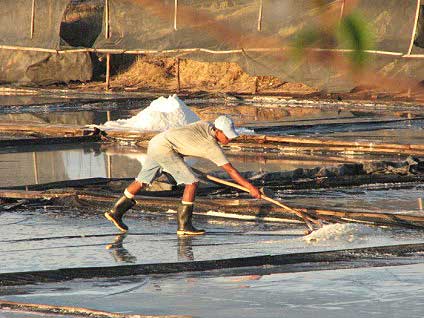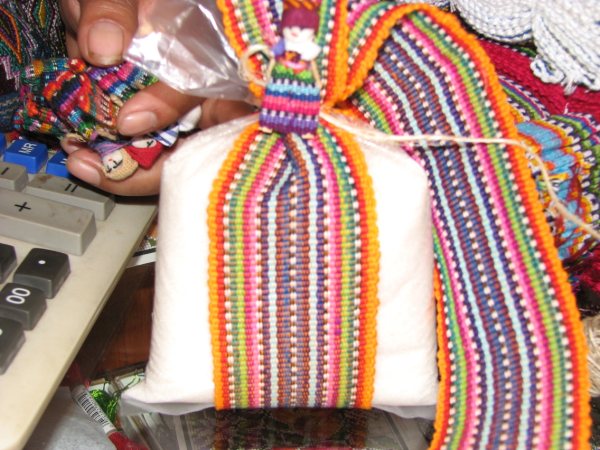You’ve probably heard reports that high salt intake is bad for you, and it’s true. An excess of salt can cause high blood pressure, heart problems, among other things, but salt is also necessary for delivering nutrients to various parts of your body and keeps your nerves firing and your muscles working, including your heart. In fact, most nutritionists recommend 500 mg of sodium a day to replace the salt we use through normal bodily functions.
An Ocean’s Bounty
Sea salt is produced both naturally and artificially. In sunny regions, such as the
 |
|
Harvesting salt from evaporation ponds in Guatemala. |
Mediterranean, China, and South America, humans produce sea salt through a process of repeat evaporation, drawing sea brine into shallow pools along the coast and allowing the brine to evaporate. Larger salt crystals form on the bottoms of the evaporation ponds, while finer sea salt crystals, known as fleur de sel, form on the surface and are scraped off quickly to preserve their fine texture.
In cooler regions, sea salt was—and still is—produced artificially by boiling sea brine in earthenware pots over large fires. As the brine evaporates, salt crystals form on the bottoms of the pots. The vessels are then cooled and broken apart, leaving large cones or slabs of salt.
Table salt is a form of refined salt—sodium chloride that has been enhanced with additives such as iodine to counter iodine deficiency in our diets, and anti-caking agents to prevent clumping. Kosher salt is also widely used and has a larger grain than table salt, and it often lacks the chemical additives found in table salt. For many, table salt and kosher salt are enough to add some extra boost to cooking and baking, but I’ve found that when used properly, sea salt can make salting your food less of a routine and more of an experience.
Salt Tasting
Sea salt is like wine; it picks up the flavors of the region it comes from. French grey salt, produced in Brittany, is believed by many in the culinary industry to be the best of sea salts; it has a subtle flavor that is not as “salty” as table or kosher salt. Hawaiian black salt, on the other hand, is said to have an earthy flavor attributed to the amount of charcoal it contains, which gives the salt a distinctive grey-pink color. Kala Namak is a sea salt used in tra di tional Indian dishes and lends an egg-like flavor to food because
 |
| Native Guatemalan weavers produce the textiles adorning packages of Maya Natural Sea Salt. |
of its sulfuric aroma. Coarse sea salt is a common ingredient in dry rubs for barbecuing and smoking meat and seafood; you can even use smoked sea salt to give your rub extra flavor. Many companies are combining sea salt with other spices—such as spicy red pepper, basil and oregano, and yellow curry—to make salting as flavorful as possible.
But my new favorite sea salt doesn’t hail from the Old World, or come in a pre-mixed spice pack. After much taste testing (with margaritas and a few willing taste-testers), I settled on the delicate Maya Natural Sea SaltTM produced in Guatemala, which relies on the ancient salt harvesting traditions first established by the Mayans 3,000 years ago. The Mayan sea salt gave a wonderful flavor to a bowl of spicy guacamole and a plate of chicken fajitas; best of all, it didn’t overpower our tangy margaritas. I confess I haven’t been able to get enough, turning to my jar of sea salt every time a recipe calls for salt and leaving the regular table salt to gather dust in the spice rack!





